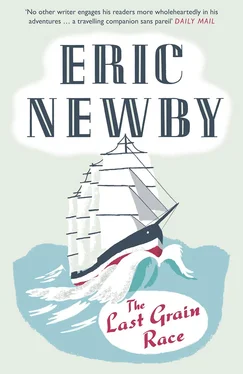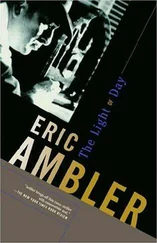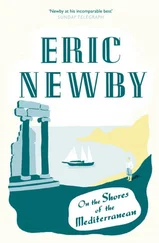When he began to speak I was surprised that he spoke really fluent English, or rather Scots, with the accent of the Clyde. Perhaps he had picked it up in the Loch Vennachar . I told him what I wanted.
‘It’s a funny thing that most of the people who get killed in these ships are Englishmen,’ he granted. ‘Limeys we used to call them. There were Limeys, Squareheads, and Dagoes. You’re a Limey. You hang on tight.’
(Readers who are discouraged by technical details about sails and sailmaking should skip the rest of this chapter.)
‘If you like,’ he went on, ‘I’ll tell you something about square sails. First, they’re not square at all, they’re four-sided and square at the head but the foot’s cut on an arc, called the roach, to allow the sails to clear the fore-and-aft stays when they’re set.
‘Most people seem to think that a sail’s cut in one piece. A sail’s cut cloth by cloth. I already know how wide the sail has to be because all square sails extend to within eighteen inches of the yardarm cleats on the head, and the depth depends on the height of the mast and the distance between the yards.
‘That’s the material over there.’ He pointed his pipe at a heavy bolt of canvas. ‘Webster’s 24˝ Standard Flax Canvas from Arbroath. The finest stuff in the world and expensive.’
‘How much would it cost to make a complete new set for the ship?’
He glared at me. ‘About £2,500. But you listen to me. It doesn’t matter to you, does it, how much it costs? I’m telling you something more important.’ His pipe had gone out so I offered him some tobacco, rather diffidently, afraid that Fribourg and Treyers’s mixture would not be strong enough for him. It made him splutter a bit at first but he appeared mollified. ‘Where was I?’ he said. Fortunately this was a purely rhetorical question and did not require an answer from me.
‘I said that a sail is cut cloth by cloth and before I start the actual cutting I have to calculate the number of cloths the width requires, allowing for seams, tabling on the leeches and slack. The leeches are the perpendicular edges, and you have to allow some slack when sewing on the bolt ropes, otherwise when the bolt rope stretches in wear, the sail might split.’
‘What is tabling?’
‘Tabling is a broad hem made on the skirt of the sail by turning the edge and sewing it down. It strengthens the sail for sewing on the bolt rope. You needn’t be afraid to ask if you don’t understand. I only get wild if you ask me questions like a bloody fool reporter.’
He continued: ‘In the depth I’ve got to allow for tabling at the head and the foot. There are gores in a sail too, they’re the angles cut at the ends of the cloth to increase the width or the depth. The canvas for the gores is cut on the cross, the longest gored side of one cloth makes the shortest side of the next. After the first gore is cut the rest are cut by it.’
‘Christ,’ I muttered, overcome by the Sailmaker’s command of technical and outmoded English with which he seemed equally at home as with his native Swedish. He began to explain how he found the number of yards of canvas needed. ‘It comes in bolts twenty-four inches wide. I add the number of cloths in the head and the foot together and halve them to make them square. Then I multiply the number of squared cloths by the depth of the sail and add to that the additional canvas contained in the foot gores, and linings and the four buntline cloths. The linings are sewn to the leeches and middle to strengthen it. The buntline cloths are to stop chafing on the sail. That’s why the sails are heavy. A course, that’s the big sail on the fore, main and mizzen – weighs more than a ton, and much more when it’s wet.
‘If you’re interested,’ went on the Sailmaker, ‘I’ll tell you something about sailmaking. This is my sail-loft.’ He waved his hand to indicate the austere and cramped quarters in which he worked. ‘And these are my tools: palm and needles; a sail-hook.’ He held up a small iron hook with a cord spliced to an eye in the shank. ‘Used for holding still the work. Marline-spikes for opening rope strands when I splice. A wooden fid for the same purpose. A pinker, like a marline-spike but straight, and a heaving-mallet.’ This was a hammer with a small cylindrical head used as a lever to haul tight the cross-stitches when sewing the bolt ropes on the sail.
‘What are the bolt ropes?’ I asked, having wanted to know all this time.
‘The bolt rope is sewn to the edge of a sail to stop it splitting. It’s either wire or hemp, mostly wire now. If it’s hemp it’s sewn with three-thread twine. The rope has to be well twisted while this is being done and it has to be cross-stitched on the leeches every twelve inches on every seam and at the middle of every cloth in the foot. In the head of the sail are the cringles through which the rope-yarns are passed securing the sail to the jackstay on the yard. In the foot are the cringles to which the buntlines are fastened and by which the sail is drawn up to the yard for furling.’
‘And what’s this?’ I asked him, holding up another hammer with a grooved head. ‘Another sort of heaving-mallet?’
‘It’s a serving-mallet,’ he replied. ‘And this is the way I serve a clew – which, by the way, is the lower corner of a sail to which the sheet is fastened.’
On the leech of the sail was a cringle, a ring made by working a strand of rope round an iron thimble. This cringle he hooked on to a bulkhead, hung off a block and tackle on the bolt rope where the clew was to be and set it up taut between a vertical iron post and the bulkhead. He took a ball of spunyarn, made two or three turns round the bolt rope, confining the end under the turns; he placed the serving-mallet on the rope, passing the yarn round the rope, the head of the mallet and the handle. ‘Take hold of this,’ he ordered, handing me the ball of yarn to pass round the rope as he turned the hammer which wound the yarn tightly on to the rope.
‘This is serving,’ said the Sailmaker, after he had made a few turns to show me the idea, ‘but first you must worm the rope by winding spun yarn along the contour of it to get a level surface and after that you parcel it with tarred canvas wrapped on before you serve it.
‘Now that you know how to make a sail,’ the Sailmaker went on optimistically, ‘you must know how to sail the ship. Do you know anything at all about square rig?’
I said that I knew very little.
‘Huh,’ he sniffed contemptuously. ‘Well, you’d better bloody well wake up and learn.’
He immediately launched into a long and clear exposition of the theory of square sails and the action of the water on the ship’s rudder. How, when Moshulu’s wheel was put to starboard, the rudder would go to starboard and the vessel turn to starboard; that the greater the angle of the rudder the more the ship’s way would be impeded. It was therefore important so to balance the ship with sails that only a slight touch on the helm was necessary.
‘Now suppose,’ said the Sailmaker, ‘that Moshulu has the wind on her starboard beam, that is to say at right angles to the direction in which she is heading. Sails are set on the foremast only and the yards are braced so that the sails are full. What happens? I’ll tell you,’ he said before I could open my mouth. ‘Her bows will fall off and her stern will come into the wind. That’s because she rotates on her pivotal turning point, which is forward of the mainmast when she’s trimmed properly. With sail set on the mizzen, her head will come into the wind. With sail on the main only she will go ahead, and if the yards are braced so that the wind blows on the forepart of the square sails, she’ll go astern.’
Читать дальше












